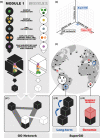Connecting high-throughput biodiversity inventories: Opportunities for a site-based genomic framework for global integration and synthesis
- PMID: 33432777
- PMCID: PMC7986105
- DOI: 10.1111/mec.15797
Connecting high-throughput biodiversity inventories: Opportunities for a site-based genomic framework for global integration and synthesis
Abstract
High-throughput sequencing (HTS) is increasingly being used for the characterization and monitoring of biodiversity. If applied in a structured way, across broad geographical scales, it offers the potential for a much deeper understanding of global biodiversity through the integration of massive quantities of molecular inventory data generated independently at local, regional and global scales. The universality, reliability and efficiency of HTS data can potentially facilitate the seamless linking of data among species assemblages from different sites, at different hierarchical levels of diversity, for any taxonomic group and regardless of prior taxonomic knowledge. However, collective international efforts are required to optimally exploit the potential of site-based HTS data for global integration and synthesis, efforts that at present are limited to the microbial domain. To contribute to the development of an analogous strategy for the nonmicrobial terrestrial domain, an international symposium entitled "Next Generation Biodiversity Monitoring" was held in November 2019 in Nicosia (Cyprus). The symposium brought together evolutionary geneticists, ecologists and biodiversity scientists involved in diverse regional and global initiatives using HTS as a core tool for biodiversity assessment. In this review, we summarize the consensus that emerged from the 3-day symposium. We converged on the opinion that an effective terrestrial Genomic Observatories network for global biodiversity integration and synthesis should be spatially led and strategically united under the umbrella of the metabarcoding approach. Subsequently, we outline an HTS-based strategy to collectively build an integrative framework for site-based biodiversity data generation.
Keywords: DNA metabarcoding; Genomic Observatories; biodiversity assessment; harmonized data generation; high-throughput sequencing.
© 2021 The Authors. Molecular Ecology published by John Wiley & Sons Ltd.
Figures

References
-
- Alberdi, A. , Aizpurua, O. , Bohmann, K. , Gopalakrishnan, S. , Lynggaard, C. , Nielsen, M. , & Gilbert, M. T. P. (2019). Promises and pitfalls of using high‐throughput sequencing for diet analysis. Molecular Ecology Resources, 19, 327–348. - PubMed
-
- Amir, A. , McDonald, D. , Navas‐Molina, J. A. , Kopylova, E. , Morton, J. T. , Zech Xu, Z. , Kightley, E. P. , Thompson, L. R. , Hyde, E. R. , Gonzalez, A. , & Knight, R. (2017). Deblur rapidly resolves single‐nucleotide community sequence patterns. American Society for Microbiology, 2, 1–7. - PMC - PubMed
-
- Andújar, C. , Arribas, P. , Yu, D. W. , Vogler, A. P. , & Emerson, B. C. (2018). Why the COI barcode should be the community DNA metabarcode for the Metazoa. Molecular Ecology, 27, 3968–3975. - PubMed
-
- Andújar, C. , Creedy, T. J. , Arribas, P. , Lopez, H. , Salces‐Castellano, A. , Perez‐Delgado, A. , Vogler, A. P. , & Emerson, B. C. (2020) Validated removal of nuclear pseudogenes and sequencing artefacts from mitochondrial metabarcode data. bioRxiv. - PubMed
Publication types
MeSH terms
LinkOut - more resources
Full Text Sources
Other Literature Sources

